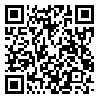Fri, Nov 14, 2025
[Archive]
Volume 20, Issue 3 (September 2024)
IJEEE 2024, 20(3): 1-11 |
Back to browse issues page
Download citation:
BibTeX | RIS | EndNote | Medlars | ProCite | Reference Manager | RefWorks
Send citation to:



BibTeX | RIS | EndNote | Medlars | ProCite | Reference Manager | RefWorks
Send citation to:
Hussein S H, K. Mohammed K. Design of a Novel Barrier-Well Asymmetric Spacer Layer Tunnel Diodes for Implantable Rectenna Circuits. IJEEE 2024; 20 (3) :1-11
URL: http://ijeee.iust.ac.ir/article-1-2738-en.html
URL: http://ijeee.iust.ac.ir/article-1-2738-en.html
Abstract: (1973 Views)
This work presents an analysis and design of the two barrier-quantum well asymmetric spacer tunnel layer (QW-ASPAT) diodes for implantable rectenna circuits application. The RF and DC characteristic of a 10×10μm2 QW-ASPAT devices based on GaAs and In0.53Ga0.47As platform was simulated and extracted by using SILVACO atlas software. The highest extracted curvature coefficient, kv value of the both QW-ASPAT devices at zero bias was about 33V-1 compared with the standard structure GaAs/InGaAs was about 13V-1. The effects of changing in the thickness of the thin AlAs-barrier, the well width, and the spacer layer are fully investigated on the non-linear relationship between current and voltage of these diodes. A CV simulation was carried out, and it was found that the addition of the quantum-well layer between spacers and barrier reduced the junction capacitance of the QW-ASPAT device when compared with standard devices. The cut-off frequency of the proposed QW-GaAs and QW-InGaAs devices are 26GHz and 46GHz respectively. Finally, we conclude that the QW-ASPAT device is the best structure and can be used for microwave rectifiers in the miniaturized integrated rectenna systems.
Type of Study: Research Paper |
Subject:
Solid State Devices And Circuits
Received: 2022/12/08 | Revised: 2025/04/11 | Accepted: 2024/08/22
Received: 2022/12/08 | Revised: 2025/04/11 | Accepted: 2024/08/22
| Rights and permissions | |
 |
This work is licensed under a Creative Commons Attribution-NonCommercial 4.0 International License. |







